|
|
|
Sort Order |
|
|
|
Items / Page
|
|
|
|
|
|
|
| Srl | Item |
| 1 |
ID:
134152
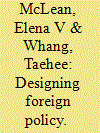

|
|
|
|
|
| Publication |
2014.
|
| Summary/Abstract |
The literature on economic sanctions has long studied sender countries' policymaking as a simple choice between imposing sanctions to extract concessions from the targeted country and doing nothing. We depart from this simplifying assumption and analyze sanctions as a multifaceted foreign policy instrument. We argue that senders design sanction policies in response to policy preferences of two domestic constituencies. Voters expect a response to an international dispute in the form of some policy, such as economic sanctions; hence, the sender's policymakers seek to demonstrate their competence in foreign affairs by imposing sanctions. Once the policymakers announce the use of sanctions, special interest groups that stand to experience economic losses when this foreign policy is implemented pressure the policymakers to choose sanction measures limiting such losses. As a result, the policymakers design sanction policies to include measures that will be less detrimental to special interest groups. We test our theoretical argument using the Threat and Imposition of Sanctions data and show that, while pressures from public opinion increase the likelihood of sanctions, special interest groups that benefit from the relationship with the target country are associated with a lower probability of the use of sanction measures that would impose substantial costs on domestic interest groups.
|
|
|
|
|
|
|
|
|
|
|
|
|
|
|
|
| 2 |
ID:
134150
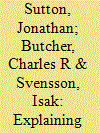

|
|
|
|
|
| Publication |
2014.
|
| Summary/Abstract |
The use of violent coercion to repress unarmed protests, such as that seen during the Arab Spring, sometimes backfires on the government - an outcome called 'political jiu-jitsu'. Examining unique global data covering extreme violence used by governments against unarmed protests from 1989 to 2011 (drawn from UCDP) and the Nonviolent and Violent Campaigns and Outcomes (NAVCO) data, this study aims to explain the conditions under which this outcome occurs. This study contributes to both the nonviolent action and one-sided violence literatures by further disaggregating this effect into both domestic and international outcomes, a distinction that has not previously been made in empirical studies. We find evidence that a pre-existing campaign infrastructure increases the likelihood of increased domestic mobilization and security defections after violent repression, but is unrelated to international backlash. Within ongoing NAVCO campaigns we find that parallel media institutions increase the likelihood of increased domestic mobilization and international repercussions after repression, and that this effect holds true for both traditional media and 'new' (i.e. internet-based) media. One of the novel contributions of this study is that we identify an important selection effect in the NAVCO data and the critical role of organizational infrastructure, especially communications infrastructure, in generating preference changes that create the conditions where killing unarmed civilians becomes costly for repressive governments. We conclude with a discussion of the potential implications of this study and avenues for future research.
|
|
|
|
|
|
|
|
|
|
|
|
|
|
|
|
| 3 |
ID:
134155
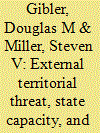

|
|
|
|
|
| Publication |
2014.
|
| Summary/Abstract |
We argue that the regional threat environment a state faces plays a consequential role in its political development and the likelihood of experiencing future intrastate wars. Challenges to a state's territorial integrity lead governments to increase their military personnel, and the resources that support these increases most often come willingly from a public that seeks security. Territorial threats are unlike other types of threats because they challenge individual lives and livelihoods, which both connects the average citizen with the state and allows for easier government extraction of necessary resources. Thus, external territorial threats increase state capacity by unifying the state and by increasing the repressive power of the central government. We identify territorial threats as both latent and realized claims against state territories and find that the presence of an external threat to territory leads to an increase in the capacity of central governments to connect and extract from its citizens, as well as the capacity to repress potential regime dissidents. We also find that the presence of a claim against a state's territory from a neighbor corresponds with a substantial decrease in the likelihood of intrastate conflict at both high and low levels of intensity. The effect of territorial threat is observed even in the short term after a territorial threat has been resolved. Our tests, using standard models of state capacity and insurgency models of conflict on a sample of all states from 1946 to 2007, are robust to multiple model specifications.
|
|
|
|
|
|
|
|
|
|
|
|
|
|
|
|
| 4 |
ID:
134151
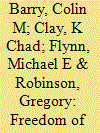

|
|
|
|
|
| Publication |
2014.
|
| Summary/Abstract |
Allowing or restricting foreign movement is a crucial policy choice for leaders. We argue that freedom of foreign movement reduces the level of civil unrest under non-democratic regimes, but only in some circumstances. Our argument relies on the trade-offs inherent in exit and voice as distinct strategies for dealing with a corrupt and oppressive state. By permitting exit and thereby lowering its relative costs, authoritarians can make protest and other modes of expressing dissatisfaction less attractive for potential troublemakers. Liberalizing foreign movement can thus function as a safety valve for releasing domestic pressure. But the degree to which allowing emigration is an effective regime strategy is shaped by the economic opportunities offered by countries receiving immigrants. We find that freedom of foreign movement and the existence of economic opportunities abroad reduce civil unrest in non-democratic states. However, at high levels of unemployment in the developed world, greater freedom of foreign movement actually increases protest.
|
|
|
|
|
|
|
|
|
|
|
|
|
|
|
|
| 5 |
ID:
134154
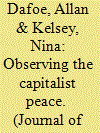

|
|
|
|
|
| Publication |
2014.
|
| Summary/Abstract |
Countries with open capital markets tend to have fewer militarized disputes and wars. Gartzke, Li & Boehmer propose that this association arises from the enhanced ability of states with open capital markets to credibly signal resolve through the bearing of economic costs ex ante to militarized escalation. We test this causal mechanism by qualitatively examining six crucial cases in which the mechanism is most likely to be operative and observable. We employ a formal case selection strategy designed to yield cases with high inferential leverage for our confirmatory test and to select cases for an exploratory analysis of scope conditions. Through analysis of media reports, government documents, and other sources, we evaluate the extent to which relevant individuals drew the appropriate inferences about market-mediated costs and resolve. We conclude that while market-mediated signaling may operate in major conflicts, it is unlikely to account for much of the association between capital openness and peace. Exploratory analysis of our cases identifies potential scope conditions, clarifies the role of different signaling mechanisms, and suggests other explanations for the peaceful behavior of countries with open capital markets.
|
|
|
|
|
|
|
|
|
|
|
|
|
|
|
|
| 6 |
ID:
134157
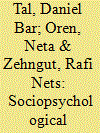

|
|
|
|
|
| Publication |
2014.
|
| Summary/Abstract |
Societies involved in intractable conflicts form conflict-supporting narratives that illuminate and justify their intergroup conflicts. These narratives play an important role in satisfying the basic sociopsychological needs of the involved individuals and collectives. In order to fulfill this role the narratives tend to be biased in favor of the in-group, selective, distorting and simplistic. This article analyzes such narratives that focus on the following major themes: Justification and Threats (of conflict), Delegitimization (of the opponent), Glorification and Victimhood (of the in-group), the in-group's need for Patriotism and Unity, and its Aspiration for Peace. Additionally, the article describes the individual and collective functions of these narratives. It also describes six main methods that are used in the narratives' construction: reliance on supportive sources, marginalization of contradictory information, magnification of supportive themes, fabrication of supportive contents, omission of contradictory contents, and use of framing language. Because conflict-supporting narratives are so functional, the involved societies struggle to support their dominance within their own society as well as in the international community. This article, therefore, presents seven methods that are used by the parties in their intrasocietal struggles - control of access to information, censorship, discrediting of contradicting information, monitoring, punishment, encouragement and rewarding, and closure of archives. Similar methods are used in the international arena struggles. Finally, it describes the process of change from adherence to the conflict-supportive narratives to the construction of new peace-supporting narratives and Adherence to Them.
|
|
|
|
|
|
|
|
|
|
|
|
|
|
|
|
| 7 |
ID:
134153
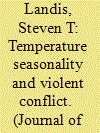

|
|
|
|
|
| Publication |
2014.
|
| Summary/Abstract |
Current climate change research suggests that certain seasonal weather patterns will be extended and others attenuated as global temperature increases. This is important because seasonal temperature change affects both the scarcity of resources during certain times of the year and the overall mobility of people living in countries that have seasonality. Consequently, these seasonal changes have implications for the onset of violent conflict, particularly as it relates to distinguishing when, where, and how it is most likely to occur. This article evaluates the relationship between monthly temperature changes, civil war onset, and various, less-organized conflict events, offering theoretical expectations for how seasonal changes and climate aberrations are related to an increased risk of violence. The results show that prolonged periods of stable, warm weather are consistently associated with an increased risk of civil war onset and non-state conflict. These findings are best explained through the strategic viability mechanism of temperature change, which allows actors to resolve their collective action problems that are often associated with poor weather conditions, while simultaneously increasing their strategic and behavioral incentives for engaging in violent conflict. Warm weather generates more resources for rebel looting and permits predictability for coordinating troop movements and strategy development. These findings are particularly salient in areas of the world affected by strong seasonality, where prolonged extensions of warm weather conditions would be regarded as both peculiar and attractive for participating in violent action. Although these findings are notable, even under the most extreme climate change scenarios, the substantive effects for these relationships are comparatively minor relative to other well-known intrastate Conflict Covariates.
|
|
|
|
|
|
|
|
|
|
|
|
|
|
|
|
| 8 |
ID:
134156
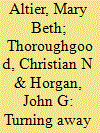

|
|
|
|
|
| Publication |
2014.
|
| Summary/Abstract |
Although research on violent extremism traditionally focuses on why individuals become involved in terrorism, recent efforts have started to tackle the question of why individuals leave terrorist groups. Research on terrorist disengagement, however, remains conceptually and theoretically underdeveloped. In an effort to enhance our understanding of disengagement from terrorism and pave the way for future empirical work, this article provides a multidisciplinary review of related research from psychology, sociology, and criminology. Significant promise for moving beyond the existing push/pull framework is found in Rusbult and colleagues' investment model from psychology and Ebaugh's research on voluntary role exit from sociology. Rusbult's investment model offers insight into when and why individuals disengage from terrorism, while accounting for individual, group, and macro-level differences in the satisfaction one derives from involvement, the investments incurred, and the alternatives available. Ebaugh's research on voluntary role exit provides a deeper understanding of how people leave, including the emotions and cuing behavior likely to be involved. The article highlights the strengths and limitations of these frameworks in explaining exit and exit processes across a variety of social roles, including potentially the terrorist role, and lends additional insights into terrorist disengagement through a review of related research on desistance from crime, disaffiliation from new religious movements, and turnover in traditional work organizations.
|
|
|
|
|
|
|
|
|
|
|
|
|
|
|
|
|
|
|
|
|